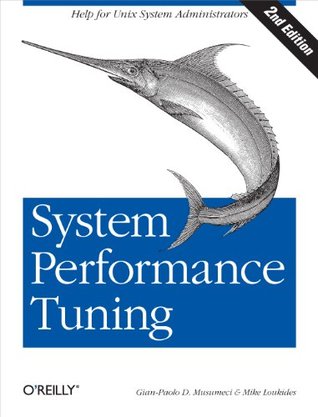Kindle Notes & Highlights
Read between
May 7 - June 18, 2022
Spin locking is accomplished entirely within the processor’s cache, so that it does not cause excess bus traffic.
PCI is a synchronous bus architecture, which means that all data transfers are performed relative to a system clock. The initial PCI specification permitted a maximum clock rate of 33 MHz, but the later Revision
2.1 specification extended this to 66 MHz.
idle time is zero, as reported by vmstat, the first thing you should check is if your system has I/O throughput problems.
The difference between them is how each memory cell is designed. Dynamic cells are charge-based, where each bit is represented by a charge stored in a tiny capacitor. The charge leaks away in a short period of time, so the memory must be continually refreshed to prevent data loss. The act of reading a bit also serves to drain the capacitor, so it’s not possible to read that bit again until it has been refreshed. Static cells, however, are based on gates, and each bit is stored in four or six connected transistors. SRAM memories retain data as long as they have power; refreshing is not
...more
cheaper and offers the highest densities of cells per chip; it is smaller, less power-intensive, and runs cooler. However, SRAM is as much as an order of magnitude faster, and therefore is used in high-performance environments.
(SDRAM) memory, which uses a clock to synchronize the input and output of signals. This clock is coordinated with the CPU clock, so the timings of all the components are synchronized. SDRAM also implements two memory banks on each module, which essentially doubles the memory throughput; it also allows multiple memory requests to be pending at once. A variation on SDRAM, called double-data rate SDRAM (DDR SDRAM) is able to read data on both the rising and falling edges of the clock, which doubles the data rate of the memory chip.
The virtual memory system is responsible for managing the associations between the used portions of this virtual address space into physical memory.
10 Mb/s Ethernet, the actual signals placed on the wire use a technique known as Manchester encoding, which allows the clock signal and the data to be transmitted in one logical parcel.
This parcel, formally called a bit-symbol, includes the logical inverse of the encoded bit followed by the actual value of the encoded bit, so that there is always a signal transition in the middle of the bit-symbol. For example, the bit “0” would be encoded in Manchester as the bit-symbol “01.” This seems silly, since it appears to double the amount of work required to send a bit of data, but just like differential signaling, it is useful in long-distance communications. Its biggest disadvantage is that it generates signal changes on the wire twice as fast as the data rate, which makes the
...more
The original standard used thick coaxial cable, and was known as 10BASE5. The 10 encodes the network data rate in Mb/s, the “BASE” refers to the use of a signaling method known as baseband, and the 5 describes the maximum segment length in 100 meter increments.
The default values for tcp_conn_req_max_q0 and tcp_conn_req_max_q are 1,024 and 128, respectively.
A certain type of denial-of-service attack, called SYN flooding, involves sending a large number of SYN packets with nonexistent source addresses. Because the second SYN is never acknowledged, the listen queue fills up and new connections get through only as old ones time out and are discarded from the queue. Whenever a dubious connection is discarded, the tcpHalfOpenDrop counter is incremented; a high value indicates that a SYN flood was likely attempted. If you observe this behavior, you can improve your protection by increasing tcp_conn_req_max_q0.
NFS is stateless, the server and client need a mechanism to determine the other’s state in order to know when to reacquire a lock (e.g., when the server is rebooted) and when to invalidate a lock (e.g., when the client unmounts the filesystem); this is the role played by statd.
Version 2 mount will default to UDP, and a Version 3 mount will default to TCP.
gethrtime(), a function call that returns the current time in nanoseconds, and directly accessing the TICK register.


